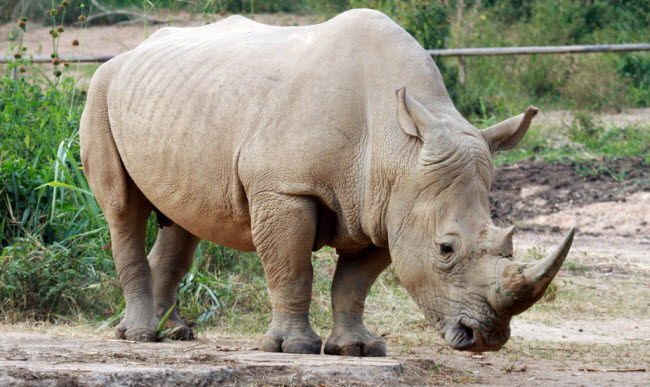The rhinoceros, a majestic mammal, is distinct from other animals due to its massive body supported by four sturdy legs, resembling tree trunks. Its head gradually tapers into a large, prominent horn at the front, and sometimes it has two. This magnificent creature descends from an ancient lineage, with its ancestors roaming the Earth 55 million years ago. One of these ancestors, the Paraceratherium, stood 7.6 meters long and 5.5 meters tall at the shoulder, making it the largest land mammal ever known. Over the ages, nearly 100 species of rhinoceroses have been identified, but today only five remain. Two of these species are found in Africa, while the remaining three inhabit Asia. All of them currently face numerous threats to their survival, primarily from poaching. Their horns are hunted and sold on the black market, fetching astronomical prices, particularly in China and Vietnam, where they are prized by wealthy consumers or used in traditional medicine. Many cultures have historically associated rhinos with brute strength, and they are often used as iconic symbols by various organizations.
The rhinoceros gets its name from its most distinctive feature: its horns, composed of keratin, the same material found in human nails and hair. The Javan and Greater one-horned rhinos possess a single horn on their snouts, while the Sumatran, Black, and White rhinos have two. The size of these horns varies, with the Black and White rhinos having much longer horns compared to the other three species. Generally, their horns lack a bony core and are relatively soft, wearing down over time with use. If broken, the horn grows back gradually. All rhino species share some common traits, including a broad chest, thick skin, poor vision, excellent hearing, and a fondness for wallowing in mud. Their thick skin serves as a protective barrier, although it is sensitive due to the proximity of blood vessels to the skin’s surface, making it prone to scarring. To shield themselves from sunburn and insect bites, rhinos frequently bathe in mud or roll in dust. Their ears can move independently, with one ear turning forward while the other turns backward, or both standing erect when detecting an intriguing sound. Rhinos also have a prominent muscle hump on their neck and shoulders to support a head that can weigh between 362 to 454 kilograms.
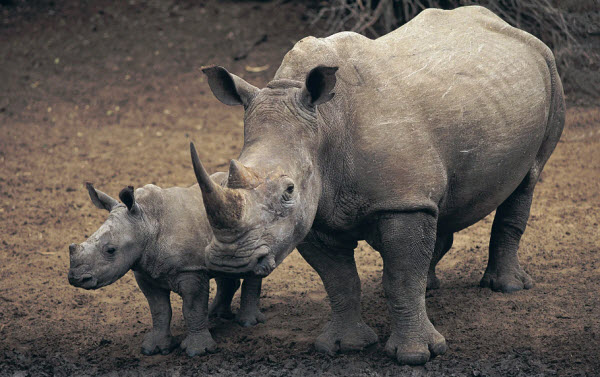
Due to their poor eyesight, rhinos rely on alarm calls from other wildlife with sharp vision, including the oxpecker bird. These birds have a mutualistic relationship with the African rhino, perching on its back to remove ticks and other parasites, even entering the ears and nostrils to reach difficult spots. In return, the oxpecker gets a meal, and the rhino benefits from the removal of bothersome insects. Oxpeckers also create a commotion to alert their rhino partner of approaching danger. Rhinos live in groups called “crashes,” a term aptly describing these large, heavy animals that might collide with anything in their path. As herbivores, they spend most of their day feeding on grasses or leaves, depending on the species. They use their horns to dig up roots and break branches for better access to food. Rhinos produce a range of vocalizations to communicate, from roars similar to a lion’s or trumpets akin to an elephant’s during fights, to squeals indicating a lost position or searching for a lost companion. Their grunts, both long and short, express anger, alerts, or surprise, while a high-pitched scream signals fear.
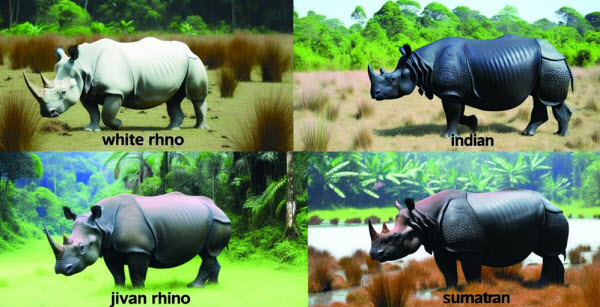
The White and Black rhinos are found in small pockets in East and Southern Africa, residing in grasslands and floodplains. Interestingly, both have the same gray-brown color. The White rhino’s name’s origin is unclear, but one story suggests that early Boer settlers in South Africa called it “wijde,” a Dutch word meaning “wide,” possibly referring to its broad mouth. In contrast, the Black rhino has a narrower mouth suited for pulling leaves and shrubs. This species can survive up to five days without water, obtaining moisture from the fresh plants it eats. The alternative names for these African rhino species are “wide-lipped” for the White rhino and “hook-lipped” for the Black rhino.
In Asia, the Greater one-horned rhino lives in Northern India and Southern Nepal, while the Javan and Sumatran rhinos inhabit small areas of Malaysia and Indonesia. These three Asian rhinos make their homes in swamps and rainforests and are known for their swimming abilities. The Greater one-horned rhino, formerly known as the Indian rhino, is covered in a layered skin with numerous folds. The Javan rhino, also called the Lesser one-horned rhino, is the rarest species and lives in dense forests of Southeast Asia. Scientists have developed an innovative method to count Javan rhinos using camera traps with sensors, which capture their images as they pass by, providing valuable data on their numbers and behavior. Sadly, fewer than 50 Javan rhinos are believed to exist in the wild, and none are in captivity. The International Rhino Foundation considers the Javan rhino the most critically endangered large mammal in the world. The Sumatran rhino, the smallest species, is covered in coarse hair and closely related to the extinct woolly rhino. Like the Javan rhino, the Sumatran rhino faces severe extinction threats, with fewer than 80 individuals believed to remain.
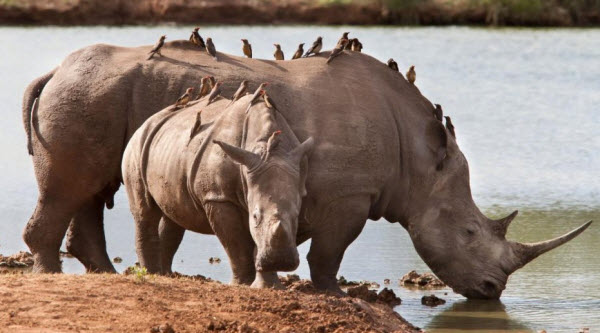
Rhinoceroses have a fascinating social structure. Dominant males control a small, exclusive territory, allowing only one or two subordinate males to share the area. Adjacent dominant males show unusual respect for territorial boundaries, rarely encroaching except for water during dry seasons. They do not follow females into another male’s territory. Dominant males invest significant time and energy patrolling their territory, marking it with urine and defecating in dung piles that act as community message boards. Females are non-territorial and roam over large home ranges, overlapping with many other females. Many male territories fall within a female’s home range. Adult female White rhinos are more social than Black rhinos and often form small groups of up to twelve, including calves and young individuals.
The three Asian rhino species differ from their African counterparts by having tusks, which they use instead of their shorter horns for fighting or defending their territory. Male tusks are longer than those of females. During confrontations, males open their mouths to display their tusks. African rhinos, lacking tusks, use their horns for defense or combat, and fights can be fatal. Up to 50% of male Black rhinos and 30% of females die from injuries sustained in combat. No other large mammal has such a high mortality rate from fighting.
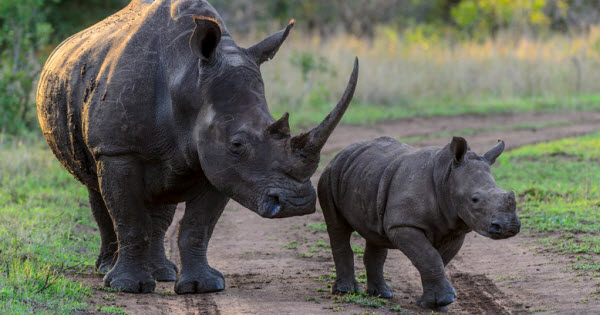
When it comes to mating, a female simply needs to appear in a male’s territory when ready. The male approaches with a series of “snorts,” inhaling followed by a snort, and may rest his chin on her rump to test her willingness to mate. If successful, she will give birth to a calf after a gestation period of 15 to 16 months. The newborn is able to stand and start nursing within two to three hours of birth and begins eating solid food between 7 to 10 days of age, though it continues to nurse until 12 to 18 months old. The mother protects her calf from predators like large cats, hyenas, and crocodiles, as well as from adult rhinos. Calves and young rhinos often play together, practicing sparring techniques and head-butting. Mothers may care for their young for up to four years unless they give birth to another calf, in which case they push the older calf to independence to make room for the new arrival. The Sumatran rhino is an exception, with calves staying with their mothers for two to three years, and it may take over two years before the female gives birth again.
For millennia, rhinoceroses lived peacefully, but the advent of powerful weaponry brought new, deadly enemies: humans. Their horns, used throughout history for medicinal purposes, especially to treat fever, are made of keratin, like our nails and hair, and have no medicinal properties. Nonetheless, thousands are slaughtered each year in Africa for their horns, which are used in traditional medicine in Asia or as dagger handles in the Middle East. By the early 1990s, the Black rhino population had plummeted by 96%, with just over 5,000 individuals remaining today. Efforts to combat poaching have intensified, with African nations working to protect rhinos, and China no longer endorsing rhino horn use in traditional medicine. Middle Eastern countries have promoted synthetic substitutes for dagger handles, reducing poaching. However, the high price of rhino horns continues to attract greedy individuals, often affiliated with criminal gangs, who kill rhinos solely for their horns. Despite this, concerted anti-poaching and habitat protection efforts have helped some rhino species recover. In Indonesia, poaching has almost been eradicated thanks to dedicated rhino protection units, though poaching remains a problem in South Africa, with an average loss of three rhinos daily. There are concerns that the Javan rhino may soon become extinct.
Identification Card
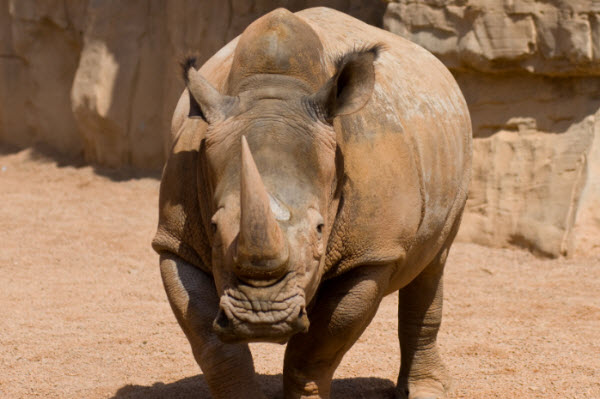
- Category: Mammals
- Order: Perissodactyla
- Family: Rhinocerotidae
- Species: White, Black, Greater One-Horned, Javan, and Sumatran
- Lifespan: 40 to 45 years
- Gestation Period: 15 to 16 months, usually one calf, rarely twins
- Birth Weight: 40 to 64 kilograms, depending on the species
- Maturity: Females 5 to 6 years, males 7 to 8 years
- Height: White rhino up to 4 meters, Sumatran rhino 2.5 to 3 meters
- Weight: White rhino up to 2300 kilograms, Sumatran rhino around 800 kilograms
- Height at Shoulder: White rhino 1.8 meters, Sumatran rhino 1.45 meters
Fun Fact:
- Despite their size, Black rhinos can run at speeds of up to 64 kilometers per hour.
- Black rhinos typically have longer horns than other species, with the front horn reaching up to 1.3 meters.
- Is it true that rhinos extinguish wildfires? This popular myth has inspired scenes in Hollywood movies and stories, and some fire departments bear their names, but no actual incidents of rhinos extinguishing fires have been recorded.
